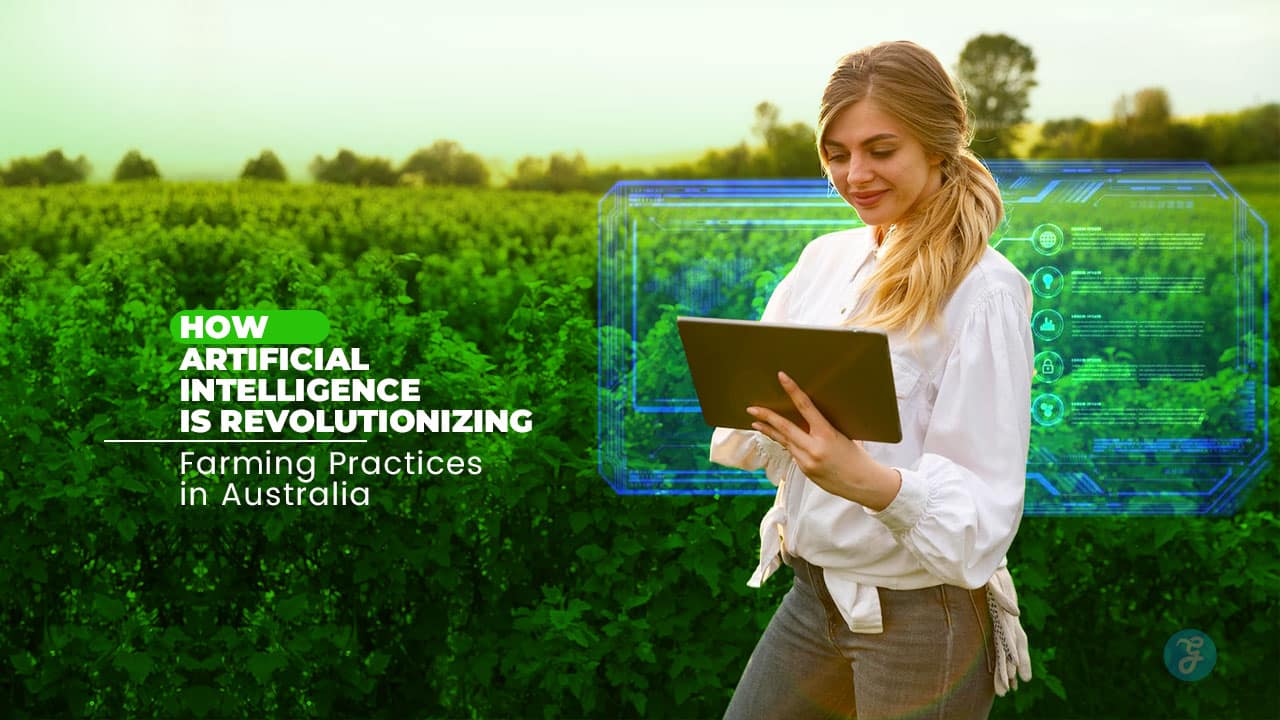Australia is known for its vast agricultural landscapes and diverse farming practices. With advancements in technology, farmers face growing challenges, from unpredictable weather patterns to increasing demand for sustainable practices.
To tackle these, the agricultural sector is embracing artificial intelligence (AI) to revolutionize farming.
Artificial intelligence in farming is transforming how crops are grown, harvested, and monitored. From using AI-powered drones to optimize irrigation systems to predictive analytics for weather patterns, Australian farmers are now leveraging innovative tools to improve productivity and reduce waste.
This article delves deep into how AI is changing the landscape of farming in Australia.
The Role of Artificial Intelligence in Farming
AI is redefining farming by automating tasks, improving decision-making, and providing data-driven insights. Here are some of the major areas where AI is making an impact:
1. Precision Agriculture
Precision agriculture represents one of the most revolutionary aspects of farming in the modern era. By leveraging artificial intelligence, precision agriculture ensures crops receive the exact nutrients, water, and care they need to thrive.
This method relies on advanced data analytics, satellite imagery, and IoT devices to monitor soil conditions, plant health, and environmental factors. With AI’s ability to analyze vast datasets, farmers can make informed decisions on when and how to irrigate, fertilize, and harvest their crops.
In Australia, where droughts and unpredictable weather patterns are common, precision agriculture reduces resource wastage while boosting crop yields.
This not only enhances productivity but also supports sustainable farming by minimizing environmental impacts. With AI, precision agriculture is becoming more accessible to Australian farmers, helping them compete on a global scale while preserving the nation’s natural resources.
Benefits:
- Reduces water and fertilizer wastage.
- Enhances crop yields.
- Minimizes environmental impact.
| Key AI Tool | Function | Impact |
| Crop Monitoring Sensors | Monitor soil and plant health | Optimized resource use |
| Satellite Imagery Analysis | Analyze large-scale farming areas | Improved yield predictions |
2. AI-Driven Crop Monitoring
AI-driven crop monitoring transforms the way farmers identify and address plant health issues. Using drones, sensors, and machine learning algorithms, AI analyzes crop images to detect signs of disease, pest infestation, or nutrient deficiency.
Unlike traditional methods, which rely on manual observation, AI systems can identify problems early and provide targeted solutions, saving time and reducing crop losses. In Australia, where pest outbreaks can devastate large farmlands, AI-driven crop monitoring ensures farmers can act quickly and efficiently.
Additionally, these systems provide detailed reports, enabling better planning and resource allocation. With the integration of AI in crop monitoring, Australian farmers can achieve healthier crops, reduce reliance on harmful pesticides, and secure their yields against unforeseen threats.
Benefits:
- Early pest detection.
- Reduced crop losses.
- Healthier plants through targeted interventions.
| Key Feature | Advantage |
| Disease Detection | Identifies affected areas quickly |
| Pest Monitoring | Minimizes pesticide use |
3. Automated Irrigation Systems
Water is one of the most precious resources in Australia, making efficient irrigation essential for sustainable farming. Automated irrigation systems powered by AI use data from weather forecasts, soil sensors, and crop requirements to optimize water usage.
These systems can adjust watering schedules based on real-time conditions, ensuring crops receive adequate hydration without waste. For Australian farmers, automated irrigation addresses challenges such as droughts and water restrictions while reducing costs. The ability to remotely monitor and control irrigation also saves labor and improves operational efficiency.
With AI-driven systems, farmers can conserve water, maintain soil health, and boost crop productivity, making automated irrigation an indispensable tool in modern agriculture.
Benefits:
- Saves water in drought-prone areas.
- Prevents overwatering and plant stress.
- Reduces manual intervention for farmers.
| Feature | Purpose | Outcome |
| AI-Powered Sensors | Measure soil moisture | Efficient water usage |
| Weather Integration | Predict rainfall and adjust watering | Water-saving strategies |
4. Livestock Management with AI
Livestock farming is a significant part of Australia’s agricultural economy, and AI is transforming how farmers care for their animals. Wearable devices, facial recognition software, and IoT-enabled sensors allow farmers to monitor livestock health, behavior, and location in real time.
AI algorithms analyze data to detect signs of illness, track feeding patterns, and predict breeding cycles, enabling proactive care and better productivity. This level of precision reduces the risk of disease outbreaks and enhances overall animal welfare.
Additionally, AI-driven systems optimize feeding schedules and manage grazing areas, ensuring efficient resource utilization. By integrating AI into livestock management, Australian farmers can improve their herd’s health, reduce costs, and achieve higher profitability.
Benefits:
- Tracks animal health and behavior.
- Optimizes feeding schedules.
- Enhances livestock productivity.
| Tool | Use Case |
| Wearable Devices | Monitor health metrics like heart rate |
| AI-Driven Feed Systems | Ensures balanced nutrition |
5. Predictive Analytics for Weather and Yield
Australia’s agriculture is heavily influenced by its unique climate, which can be unpredictable and harsh. AI-powered predictive analytics help farmers stay ahead by forecasting weather patterns, rainfall, and temperature changes.
These insights allow farmers to plan planting, irrigation, and harvesting schedules more effectively. Predictive models also estimate crop yields based on historical data, soil conditions, and environmental factors. This information helps farmers make informed decisions, manage risks, and maximize profitability.
For Australian farmers, predictive analytics reduces uncertainty and enhances their ability to adapt to climate challenges, ensuring stable agricultural outputs despite fluctuating conditions.
Benefits:
- Increases preparedness for climate variability.
- Improves harvest timing.
- Maximizes profitability.
| Feature | Impact |
| Weather Prediction | Accurate rain and drought forecasts |
| Yield Analysis | Optimizes harvesting strategies |
6. Autonomous Machinery and Robotics
The integration of autonomous machinery and robotics is revolutionizing labor-intensive farming tasks. In Australia, where labor shortages are a recurring issue, AI-powered tractors, drones, and harvesters provide a reliable solution.
These machines operate with high precision, performing tasks such as planting, fertilizing, and harvesting with minimal human intervention. AI ensures that these machines adapt to different terrains and conditions, delivering consistent performance. For farmers, this means reduced labor costs, faster operations, and higher efficiency.
Autonomous machinery also minimizes errors and ensures optimal resource utilization, making it an invaluable asset for modern farms in Australia.
Benefits:
- Saves time and labor costs.
- Ensures precision in tasks like seeding and harvesting.
- Operates in adverse weather conditions.
| Machinery | Purpose | Outcome |
| Autonomous Tractors | Planting and seeding | Consistent crop coverage |
| Robotic Harvesters | Fruit and vegetable picking | Minimal crop damage |
7. AI for Sustainable Farming Practices
Sustainability is a growing priority for Australian agriculture, and AI is playing a critical role in achieving this goal. By analyzing data from various sources, AI recommends eco-friendly practices such as crop rotation, intercropping, and organic farming.
AI-powered tools also optimize fertilizer and pesticide use, reducing environmental harm. In addition, AI supports biodiversity by promoting the use of natural pest control methods and conservation practices.
For Australian farmers, sustainable farming practices not only protect the environment but also improve soil health and long-term productivity. AI ensures that these practices are easy to implement and monitor, making sustainability more accessible to farmers.
Benefits:
- Promotes crop rotation for soil health.
- Reduces overuse of fertilizers and pesticides.
- Supports biodiversity.
8. AI in Supply Chain Optimization
Efficient supply chain management is essential for getting agricultural products from farms to consumers. AI streamlines this process by predicting demand, tracking inventory, and optimizing logistics.
For example, AI can analyze market trends to help farmers decide when and where to sell their produce for maximum profit. In Australia, where long transportation distances can impact product quality, AI ensures timely deliveries and reduces food waste. AI-driven supply chain solutions also enhance transparency, allowing consumers to trace the origin of their food.
By integrating AI into supply chain management, Australian farmers can improve profitability, reduce waste, and build trust with consumers.
Benefits:
- Cuts down transportation delays.
- Minimizes inventory waste.
- Enhances customer satisfaction.
Challenges of AI Adoption in Australian Farming
While AI offers numerous benefits, challenges like high costs, lack of technical skills, and data privacy concerns hinder its widespread adoption. Addressing these issues through government support and training programs is crucial for maximizing AI’s potential in farming.
| Challenge | Impact | Solution |
| High Initial Costs | Limits accessibility for small farms | Government subsidies |
| Technical Knowledge Gap | Reduces efficiency of AI tools | Training programs |
Final Thoughts
Artificial intelligence in farming is not just a technological advancement; it’s a revolution reshaping agriculture in Australia. By integrating AI, farmers can enhance productivity, reduce environmental impact, and ensure food security for future generations.
As the agricultural sector continues to embrace AI, the promise of smarter, more sustainable farming practices will become a reality. Whether through precision agriculture, automated irrigation, or supply chain optimization, AI is set to transform Australian farming into a global model of innovation and sustainability.
Take the leap today and explore how AI can revolutionize your farming practices!
Let me know if you’d like additional insights or elaboration on any section!






































